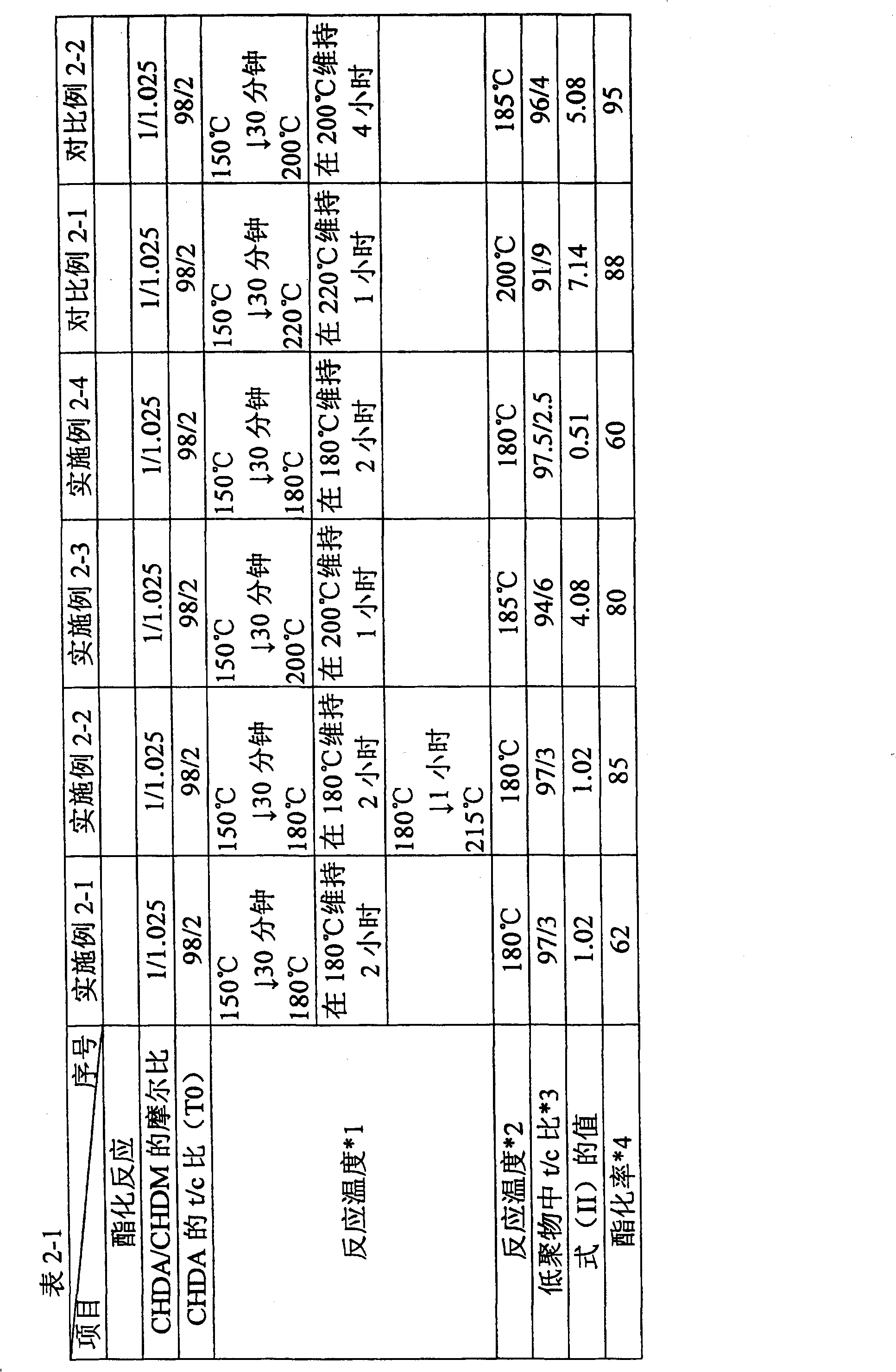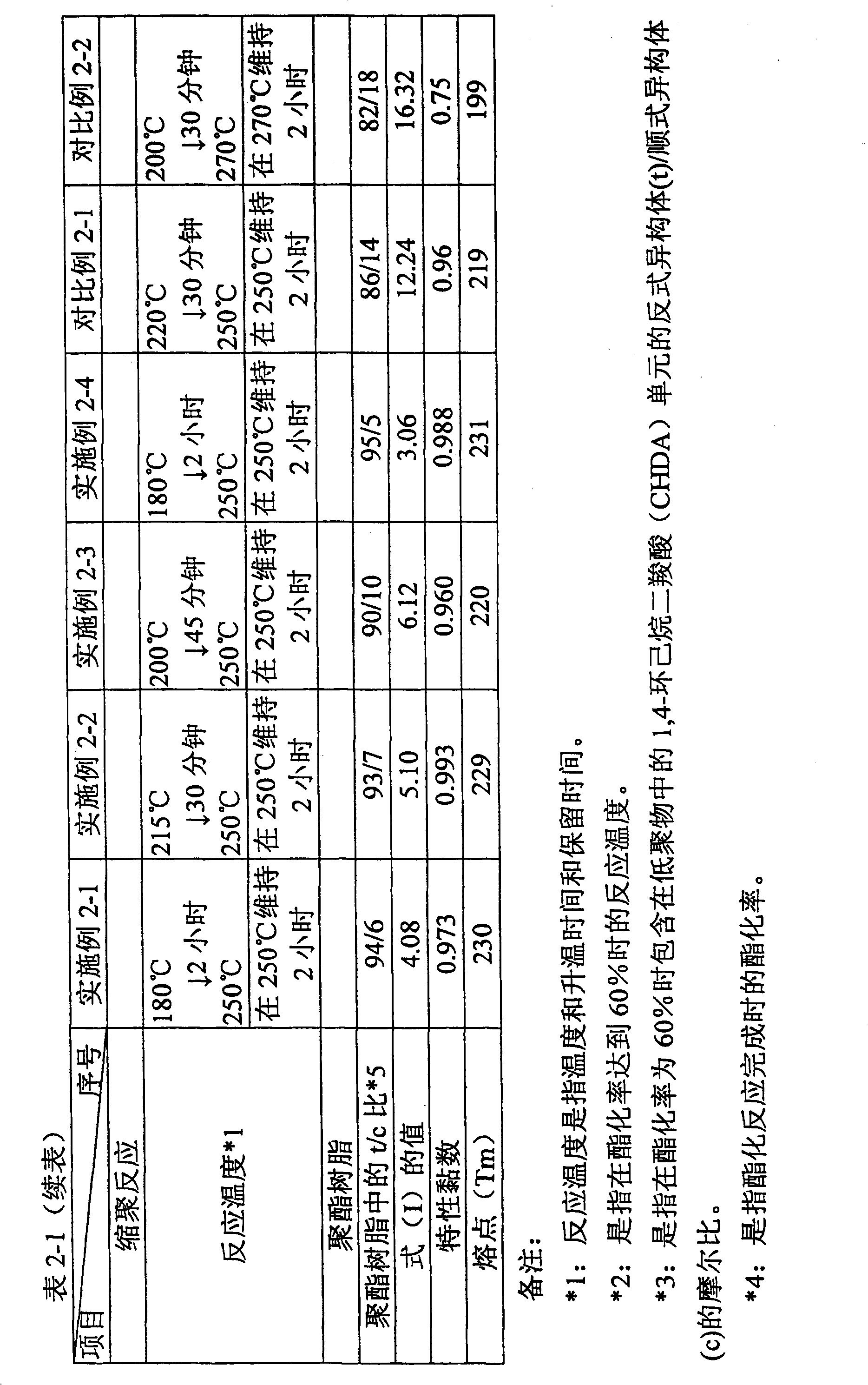Polyester resin and method for producing the same
A technology of polyester resin and oligomer, applied in the field of polyester resin and its preparation, can solve the problems of poor heat resistance, poor hydrolysis resistance of polyester resin, unable to obtain polyester resin with high melting point, etc. The effect of excellent heat resistance
- Summary
- Abstract
- Description
- Claims
- Application Information
AI Technical Summary
Problems solved by technology
Method used
Image
Examples
preparation example Construction
[0029] In the production method of the present invention, the diol used in the esterification reaction preferably contains 1,4-CHDM. 1,4-CHDM in the diol is preferably at least 60 mol%, and if it is less than 60 mol%, the polymerizability will deteriorate.
[0030] In addition, from the viewpoint of availability, 1,4-CHDM is usually a mixture of trans-isomers and cis-isomers. However, it is desirable that the ratio of the trans isomer / cis isomer is usually selected from 100 / 0 to 60 / 40 in accordance with the required heat resistance and the like depending on the specific use. If the ratio of trans / cis is lower than 60 / 40, the heat resistance of the resulting polyester resin will be poor.
[0031] The diol component used to produce the polyester resin of the present invention is not particularly limited as long as it can be directly esterified with the above-mentioned dicarboxylic acid component. Diols containing 1,4-cyclohexanedimethanol (1,4-CHDM) are preferred. The proport...
Embodiment 1-1
[0091] In the reactor equipped with stirrer, distillation tube and decompression device, add 92.12g 1,4-CHDA (trans isomer / cis isomer=98 / 2), 79.07g 1,4-CHDM ( Adding molar ratio of CHDM / CHDA: 102.5 / 100) and 0.54g (0.31 mmol) of 10% by weight tetraethylammonium hydride aqueous solution, heated to 150° C. in an oil bath in a nitrogen stream, then heated to 200°C, and then kept at 200°C for 1 hour to carry out the esterification reaction. Then add 0.88g (0.155 mmol) n-butanol solution of 6% by weight tetra-n-butyl titanate to the reactor, and while raising the internal temperature from 200°C to 250°C in 45 minutes, gradually lower the temperature in the reactor. pressure for the polycondensation reaction. After maintaining the absolute pressure in the reactor at 0.1 kPa and reacting for 2.5 hours at a temperature of 250° C., the obtained polyester resin was pulled into water in the form of strands and pelletized. The intrinsic viscosity, melting point, and ratio of trans isomer...
Embodiment 1-2
[0093] The polycondensation reaction was carried out under the same conditions as in Example 1-1, except that the aqueous solution of 10% by weight of tetraethylammonium hydride was changed to an aqueous solution of 64 mg (0.078 mmol) of 10% by weight of sodium acetate. The intrinsic viscosity, melting point, and ratio of trans isomer / cis isomer in the 1,4-CHDA component of the obtained polyester resin are shown in Table 1-1.
PUM
 Login to View More
Login to View More Abstract
Description
Claims
Application Information
 Login to View More
Login to View More - R&D
- Intellectual Property
- Life Sciences
- Materials
- Tech Scout
- Unparalleled Data Quality
- Higher Quality Content
- 60% Fewer Hallucinations
Browse by: Latest US Patents, China's latest patents, Technical Efficacy Thesaurus, Application Domain, Technology Topic, Popular Technical Reports.
© 2025 PatSnap. All rights reserved.Legal|Privacy policy|Modern Slavery Act Transparency Statement|Sitemap|About US| Contact US: help@patsnap.com


